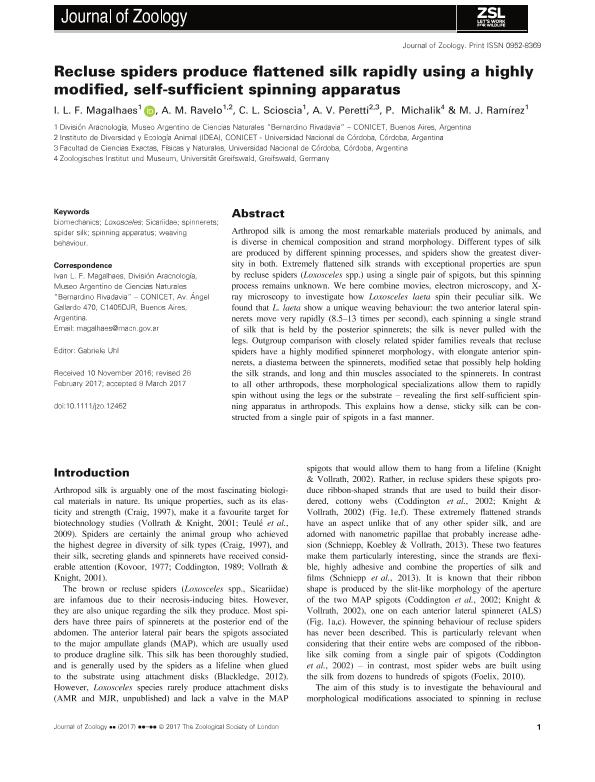Artículo
Recluse spiders produce flattened silk rapidly using a highly modified, self-sufficient spinning apparatus
Fiorini de Magalhaes, Ivan Luiz ; Ravelo, A. M.; Scioscia, Cristina Luisa
; Ravelo, A. M.; Scioscia, Cristina Luisa ; Peretti, Alfredo Vicente
; Peretti, Alfredo Vicente ; Michalik, Peter; Ramirez, Martin Javier
; Michalik, Peter; Ramirez, Martin Javier
 ; Ravelo, A. M.; Scioscia, Cristina Luisa
; Ravelo, A. M.; Scioscia, Cristina Luisa ; Peretti, Alfredo Vicente
; Peretti, Alfredo Vicente ; Michalik, Peter; Ramirez, Martin Javier
; Michalik, Peter; Ramirez, Martin Javier
Fecha de publicación:
09/2017
Editorial:
Wiley Blackwell Publishing, Inc
Revista:
Journal Of Zoology
ISSN:
0952-8369
e-ISSN:
1469-7998
Idioma:
Inglés
Tipo de recurso:
Artículo publicado
Clasificación temática:
Resumen
Arthropod silk is among the most remarkable materials produced by animals, and is diverse in chemical composition and strand morphology. Different types of silk are produced by different spinning processes, and spiders show the greatest diversity in both. Extremely flattened silk strands with exceptional properties are spun by recluse spiders (Loxosceles spp.) using a single pair of spigots, but this spinning process remains unknown. We here combine movies, electron microscopy, and X-ray microscopy to investigate how Loxosceles laeta spin their peculiar silk. We found that L. laeta show a unique weaving behaviour: the two anterior lateral spinnerets move very rapidly (8.5-13 times per second), each spinning a single strand of silk that is held by the posterior spinnerets; the silk is never pulled with the legs. Outgroup comparison with closely related spider families reveals that recluse spiders have a highly modified spinneret morphology, with elongate anterior spinnerets, a diastema between the spinnerets, modified setae that possibly help holding the silk strands, and long and thin muscles associated to the spinnerets. In contrast to all other arthropods, these morphological specializations allow them to rapidly spin without using the legs or the substrate - revealing the first self-sufficient spinning apparatus in arthropods. This explains how a dense, sticky silk can be constructed from a single pair of spigots in a fast manner.
Archivos asociados
Licencia
Identificadores
Colecciones
Articulos(IDEA)
Articulos de INSTITUTO DE DIVERSIDAD Y ECOLOGIA ANIMAL
Articulos de INSTITUTO DE DIVERSIDAD Y ECOLOGIA ANIMAL
Articulos(MACNBR)
Articulos de MUSEO ARG.DE CS.NAT "BERNARDINO RIVADAVIA"
Articulos de MUSEO ARG.DE CS.NAT "BERNARDINO RIVADAVIA"
Citación
Fiorini de Magalhaes, Ivan Luiz; Ravelo, A. M.; Scioscia, Cristina Luisa; Peretti, Alfredo Vicente; Michalik, Peter; et al.; Recluse spiders produce flattened silk rapidly using a highly modified, self-sufficient spinning apparatus; Wiley Blackwell Publishing, Inc; Journal Of Zoology; 303; 1; 9-2017; 27-35
Compartir
Altmétricas



